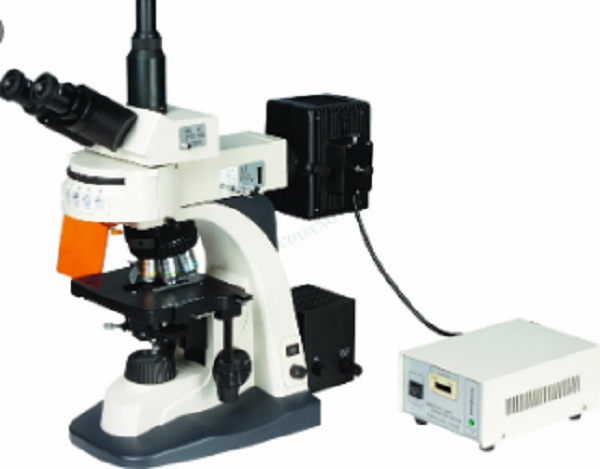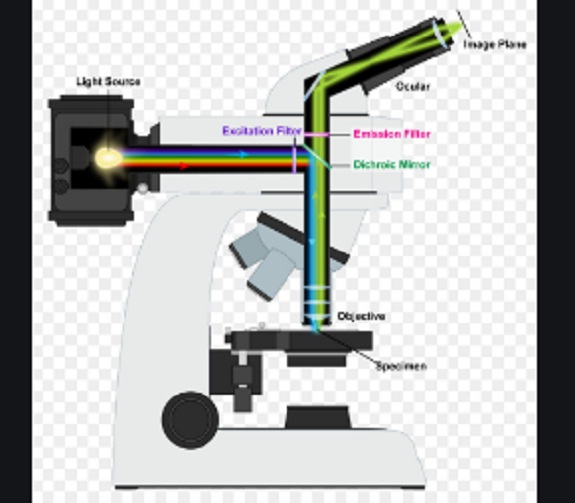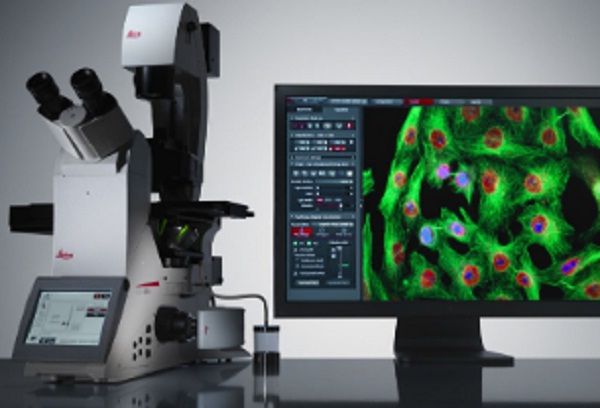- What is a fluorescence microscope? 🔬👨🔬
- Scientific principle of fluorescence microscope 🔬🦠
- Fluorescence microscope parts 🧫🧬
- Inverted fluorescence microscope
- Uses and applications of the fluorescence microscope 👩🔬💚
- Advantages associated with the fluorescence microscope
- Limitations associated with the fluorescence microscope
In laboratories, or rather in the scientific field, the amount of tools, instruments and materials is amazing. However, there are few that can be seriously said to mark a before and after. This is the case of the microscope, an apparatus that opened our eyes to a completely different world from ours. Being able to visualize objects or organisms of minimal size has greatly changed our way of understanding things. In this article you will be amazed with the characteristics of the fluorescence microscope, one of the latest advances in microscopy.
What is a fluorescence microscope? 🔬👨🔬
It is an electronic and mechanical equipment that arises from the modification or variation of the basic observation techniques of the optical microscope. It was created at the beginning of the twentieth century by scientists Carl Reichert, Heinrich Lehmann and August Köhler. It can be said that it is an optical microscope which uses phosphorescence and fluorescence.
For the study of the organic and inorganic substances and elements. So to clarify things better let's define what is fluorescence, this is the emission of light by a substance that previously it has absorbed radiation or light. Specifically it is a kind of photoluminescence. It differs from phosphorescence in that it cannot emit immediately the radiation it receives.


Scientific principle of fluorescence microscope 🔬🦠
Basic microscopy is based on staining using dyes the cellular components that are normally colorless and cannot be distinguish under the microscope. Then by contrast it is allowed to distinguish structures for their study. Fluorescence microscopy took this idea fundamental and I modify it for your own use.
So they decided to supplant ordinary dyes with dyes fluorescers that are molecules capable of absorbing light over a length of specific wave. To subsequently with a certain time of delay issue or reflecting its own light at a longer wavelength than it received. The delay between absorption and emission is really negligible, since we are talking about nano seconds. These dyes that possess this ability are it is known as fluorochromes or fluorophores.
So once this stimulus is done the second light it can be filtered to reveal the presence and location of fluorophores. Producing an image based on the second light source which is the generated by the sample. Thus allowing its further study.
Fluorescence microscope parts 🧫🧬
As we already mentioned, the fluorescence microscope is basically a modified optical microscope. So structurally it possesses the same basic elements, then we will mention only those that have been added or modified. Which are the following:
Fluorochromes or fluorescent dyes
Are fluorescent chemical compounds typically some aromatic groups combined to planar or cyclic molecules. Which possess the ability to emit light upon excitation by light, have been created in many versions.
They are usually modified to bind to the biological molecule of interest in the studio.
Light source
The light used in this microscope is of certain types specific to achieve the correct absorption and subsequent excitation of the fluorochrome. So we can mention four types that are the most widely used.
Included are the LED light, xenon chest lamps, lasers and steam lamp of mercury.
Excitation filter
It is a bandpass filter that only allows the passage of the specific wavelengths that are absorbed by fluorochrome.
Minimizing and avoiding excitation by other fluorescent sources.
Dichroic mirror
It is a second filter a little more specific, it is of type color that is used to pass light in a select way in a precise range of color.
Emissions filter.
Is a third filter no longer addressed in the light of incidence if not to the issue of the sample. It is a bandpass filter that only it allows the passage of the specific lengths emitted by the fluorescent dye.
Thus blocking all unwanted light, especially excitation light. This is how it guarantees a clear fluorescence with a dark background.


Inverted fluorescence microscope
An inverted fluorescence microscope is a type of microscope that uses fluorescence to visualize biological samples and other specimens. It is called "inverted" because the sample is placed on the stage below the objective lenses, with the illumination source above the stage. This design allows for greater access to the sample and improved visualization of the specimen, especially for larger and thicker samples. The fluorescence technique involves exciting fluorophores, or fluorescent molecules, in the sample with light of a specific wavelength, causing them to emit light at a longer, distinguishable wavelength that can be captured and imaged by the microscope's camera. This allows for the visualization of specific structures or processes within the sample that would otherwise be difficult or impossible to see with traditional light microscopy.
Uses and applications of the fluorescence microscope 👩🔬💚
Microscopy in general is a wide-ranging tool scope for what are the current scientific researches.
Every day it gets a little better with the application of specialized dyes for the identification of compounds and structures. So we can say that his general application is to identify structures and compounds in samples biological both living and fixed.
Advantages associated with the fluorescence microscope
Folk method for the study of behavior in images of living cells.Specificity in compounds by the application of modified stains for binding to specific molecules.High sensitivity, specifically 50 molecules per cubic micrometer.Molecular differentiation in a group what is it refers to the fact that different molecules of different colors can be stained in a same study.
Limitations associated with the fluorescence microscope
Fluorochromes present a flaw in the fluorescence emission when subjected to photo bleaching. Which is a the process of chemical damage to excited electrons during fluorescence.
This could generate false results without prior evidence.Cell susceptibility to phototoxicity without previous history of exposure to short wavelengths.This technique and instrument only allows observation of specific structures with prior marking. Which only allows analyze the only objective of the study and not a general picture.
We have already described the main characteristics of the fluorescence microscope, with this we show the progress achieved in different equipment and techniques. Currently the biological study is a fundamental pillar of many advances in medicine and pharmacy. If you want to know about other types of advances in microscopy, visit our upcoming publications.
Fluorescence microscope course
There are several options for taking a course on inverted fluorescence microscopy:
- Online courses: Websites such as Coursera, Udemy, and LinkedIn Learning offer courses on fluorescence microscopy and its applications.
- College/University courses: Some universities offer courses on fluorescence microscopy as part of their science or biology programs.
- Workshops: Many organizations and companies offer workshops or training sessions on fluorescence microscopy.
- Conferences: Attending conferences in the field of microscopy can provide opportunities to learn more about fluorescence microscopy through lectures, workshops, and demonstrations.
- Hands-on training: Many microscope manufacturers offer hands-on training sessions for users of their fluorescence microscopes.
- Scientific journals: Scientific journals such as Journal of Microscopy and Journal of Biomedical Optics often publish articles on fluorescence microscopy and its applications
When do we use a fluorescence microscope labster ?
A fluorescence microscope is used in various scientific and medical fields for the visualization and analysis of fluorescently labeled samples. Some common applications include:
- Cell Biology: For the study of cell structure and function, scientists use fluorescence microscopy to visualize cellular components, such as organelles, proteins, and nucleic acids, that have been labeled with fluorescent dyes.
- Biochemistry: Fluorescence microscopy is used to study the behavior of molecules and enzymes in living cells and to monitor chemical reactions in real-time.
- Pathology: In medical research, fluorescence microscopy is used to visualize disease-causing organisms, such as bacteria and viruses, and to study the progression of diseases.
- Neuroscience: Researchers use fluorescence microscopy to study the structure and function of neurons, the signaling pathways they use, and their interactions with other cells.
- Drug Discovery: Fluorescence microscopy is also used in the drug discovery process to visualize the interactions between drugs and cells, and to assess the efficacy of new drugs.
In summary, fluorescence microscopy is a powerful tool for visualizing and analyzing a wide range of biological and medical specimens and is widely used in various fields of scientific and medical research.
Nikon fluorescence microscope
Nikon is a well-known brand in the field of microscopy, and they offer several models of fluorescence microscopes. Some of the popular models are:
- Nikon Eclipse Ti-U Fluorescence Microscope
- Nikon Eclipse Ci-L Microscope
- Nikon Eclipse Ni-E Microscope
- Nikon A1R-MP+ Confocal Microscope
- Nikon N-STORM Super-Resolution Microscope
These models offer a range of features, including high-resolution imaging, advanced software, and multiple laser options. Depending on the specific needs of the laboratory, different models may be more suitable for a particular application.
Leica fluorescence microscope
Leica offers several models of fluorescence microscopes, including:
- Leica DMi8: a high-end inverted fluorescence microscope for live cell imaging.
- Leica DMI3000 B: a inverted microscope for high-resolution imaging and analysis.
- Leica TCS SP8: a multiphoton laser scanning microscope for deep tissue imaging.
- Leica DM6 B: a inverted microscope designed for routine and advanced fluorescence applications.
- Leica SP5: a confocal laser scanning microscope for fluorescence imaging.
These are some of the most popular models offered by Leica. It's worth noting that these models may change over time and other models may be added to the line-up. It's always best to check with Leica or a Leica representative for the latest information on their fluorescence microscope offerings.
Epi fluorescence microscope
- Leica DMi8 Epi-Fluorescence Microscope
- Zeiss Axio Observer Epi-Fluorescence Microscope
- Olympus IX83 Epi-Fluorescence Microscope
- Nikon Eclipse Ti-U Epi-Fluorescence Microscope
- JEOL JEM-1400Plus Epi-Fluorescence Microscope
- Agilent G2251B Epi-Fluorescence Microscope
- Bruker Ultraflex III Epi-Fluorescence Microscope
It's worth mentioning that these are just a few examples and many other brands and models are available. The specific model you choose would depend on the specific application and research requirements you have.
Zeiss fluorescence microscope
Zeiss is a well-known brand in the field of microscopy and offers a range of fluorescence microscopes. Some of the popular models of Zeiss fluorescence microscopes include:
- Axio Observer.Z1 - A highly versatile fluorescence microscope that can be configured for a variety of applications.
- LSM 880 - A high-end laser scanning microscope for advanced fluorescence imaging applications.
- Axio Imager.Z2 - A fluorescence microscope designed for high-resolution imaging and multi-color imaging.
- Axio Observer.D1 - A compact fluorescence microscope designed for live cell imaging and other applications that require high performance and ease of use.
-
These are just a few examples of Zeiss fluorescence microscope models. Zeiss also offers customized solutions for specific applications, so the best model for a particular use will depend on the specific requirements of the user.
- LSM 710 - A laser scanning microscope for advanced fluorescence imaging applications.
These are just a few examples of Zeiss fluorescence microscope models. Zeiss also offers customized solutions for specific applications, so the best model for a particular use will depend on the specific requirements of the user.
Olympus fluorescence microscope
Olympus is a well-known brand in the field of microscopy and offers a wide range of fluorescence microscopes. Some of the popular models from Olympus include:
- IX73 Inverted Fluorescence Microscope
- IX83 Inverted Fluorescence Microscope
- BX53F Fluorescence Microscope
- BX63 Fluorescence Microscope
- BX93 Epi-fluorescence Microscope
- BX53M Fluorescence Microscope
- BX61WI Inverted Fluorescence Microscope
- BXFM Fluorescence Microscope
Note that the prices of these models can vary greatly based on the features, specifications, and accessories included.
Fluorescence microscope price
The price of a fluorescence microscope can vary greatly depending on several factors such as the brand, model, features and specifications, and the intended use. Basic fluorescence microscopes can start from several thousands of dollars, while advanced models with multiple imaging capabilities, advanced software, and higher quality optics can cost tens of thousands of dollars. The price range is quite broad, and can be anywhere from $5,000 to $100,000 or more.

